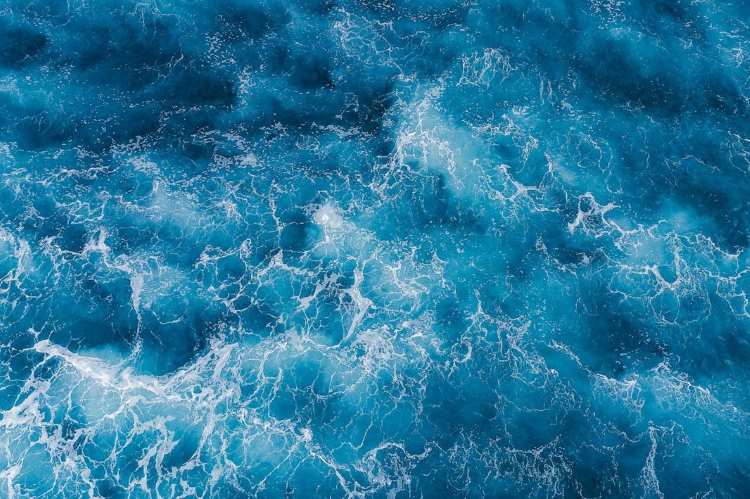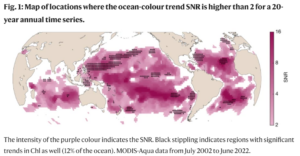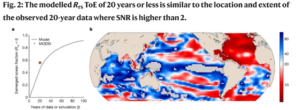
Recent scientific research show that the colour of oceans is undergoing a transformation because of climate change. The clear blue oceans are increasingly turning green, particularly near the equator, while some regions are shifting to deeper blues. This phenomenon, driven largely by rising global temperatures, represents more than just an aesthetic alteration — it signifies profound changes within marine ecosystems.
Scientific studies highlight the significant changes occurring in the oceans. The European State of the Climate report, published by the European Union’s Copernicus Climate Service, reveals that chlorophyll levels — a green photosynthetic pigment found in phytoplankton — are experiencing dramatic fluctuations. For instance, chlorophyll levels in the Norwegian Sea and the Atlantic Ocean north of the UK were 200-500% higher than average in April 2023. Conversely, levels were 60-80% lower in the ocean west of the Iberian Peninsula during the same period. Such shifts are indicators of warming ocean temperatures and changes in phytoplankton populations.
READ I Covishield row: A shadow on vaccine trust, not on progress
Oceans changing colour
Research conducted by the European State of the Climate report and studies led by BB Cael highlight the role of advanced satellite technology in detecting subtle changes in ocean colour. Instruments such as the Moderate Resolution Imaging Spectroradiometer aboard NASA’s Aqua satellite have been crucial in this endeavour. By measuring the wavelengths of light reflected off the ocean’s surface, these satellites provide detailed data on the concentration of chlorophyll and other pigments. This capability has enabled scientists to monitor and map changes in ocean colour over time, revealing significant trends that would otherwise go unnoticed.
Phytoplankton, the microscopic organisms that form the base of the marine food web, play a crucial role in maintaining oceanic health. They contain chlorophyll, which gives them their green colour and enables them to photosynthesise, converting sunlight into energy. Phytoplankton also help sequester carbon dioxide from the atmosphere, thus playing a vital part in the global carbon cycle.
Detecting changes in colour
Traditional methods of studying oceanic changes, such as direct sampling, are limited by scale and time. Satellite remote sensing, however, offers a comprehensive solution. The Moderate Resolution Imaging Spectroradiometer aboard NASA’s Aqua satellite has been collecting data for over two decades. These instruments measure various wavelengths of light reflected off the ocean’s surface, providing insights into the concentration of chlorophyll and other pigments.
BB Cael, a scientist at the National Oceanography Centre in Southampton, UK, used these satellite data to map changes in ocean colour over the past 20 years. His study, published in Nature, revealed that more than half of the world’s ocean area (56%) has experienced a change in colour. This area is larger than all the world’s landmass combined, highlighting the vast scale of this phenomenon.


The analysis of Remote-Sensing Reflectance (Rrs) data has shown that climate-change trends in ocean colour emerge more rapidly than previously thought. Unlike chlorophyll measurements, which require over 30 years of data to detect trends, Rrs trends can be observed within 20 years. This is due to Rrs being multivariate, capturing a wider range of optical properties of the ocean’s surface. As a result, Rrs data provide a clearer and faster indication of changes in marine ecosystems driven by climate change.
Cael and his team created virtual Earth models to simulate two different historical scenarios: one without climate change and one with it. These models allowed scientists to compare how ocean colours would diverge over time due to climate change. The findings showed that the colours in 56% of the world’s oceans had changed, particularly in tropical regions near the Equator. This innovative approach provided robust evidence that the observed changes in ocean colour are closely linked to human-induced climate change.
Climate change and marine ecosystems
The changing colour of the oceans reflects significant shifts in marine ecosystems. Phytoplankton populations are moving northward at an estimated rate of 35 kilometres per decade, driven by warming waters. This migration affects the distribution of zooplankton, tiny animals that feed on phytoplankton, leading to changes in the marine food web. As a result, fish populations and other marine species that rely on these organisms are also impacted.
Changes in ocean colour indicate shifts in upper-ocean stratification and mixed-layer depth. These changes can significantly affect plankton community structures and biomass. As the ocean stratifies differently due to warming temperatures, the availability of nutrients and light conditions for phytoplankton will change, leading to alterations in their distribution and abundance. This, in turn, impacts the entire marine food web, from microscopic organisms to large marine mammals.
These shifts are not merely academic concerns. Phytoplankton are foundational to ocean health, influencing everything from oxygen production to the availability of nutrients for marine life. Changes in their populations can lead to cascading effects throughout the ecosystem, affecting biodiversity and the resilience of marine habitats.
Need urgent action
The colour change in the oceans is a clear signal of the broader impacts of climate change. As surface ocean temperatures continue to rise, these shifts are likely to become more pronounced, with far-reaching consequences for marine life and global climate systems.
Addressing this issue requires concerted efforts at multiple levels. Policymakers must prioritise climate action, including reducing greenhouse gas emissions and supporting renewable energy initiatives. Additionally, international cooperation is essential to protect marine biodiversity, as the effects of climate change on the oceans are a global concern.
Moreover, ongoing investment in satellite monitoring and oceanographic research is crucial. The data provided by long-term satellite missions like MODIS-Aqua are invaluable for understanding and responding to these changes. Continued advancements in remote sensing technology will enhance the ability to detect and interpret trends in ocean colour and ecosystem health.
The continued operation of long-term satellite missions like MODIS-Aqua is vital for monitoring changes in ocean colour and marine ecosystems. However, with the planned end of the MODIS-Aqua mission, the integration of data from multiple satellite missions becomes crucial. Developing and refining methods to merge data from different satellites will enhance the ability to detect and interpret trends in ocean colour, ensuring that scientists can continue to track the impacts of climate change on a global scale.
The changing colours of the oceans are a stark reminder of the pervasive impact of climate change. This phenomenon, driven by shifts in phytoplankton populations and rising temperatures, signals significant alterations in marine ecosystems. It is imperative that this issue is taken seriously, leveraging scientific research and international collaboration to mitigate the effects of climate change and protect the oceans for future generations. The health of the planet depends on it.

